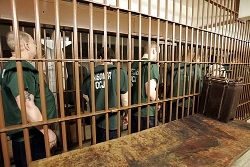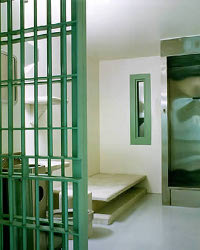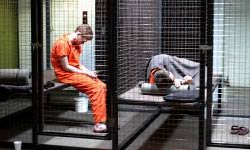Prisoners of the Census: How the incarcerated are counted distorts our politics
By Christian Smith-Socaris, Progressive States Network




Currently, 1 in 100 American adults are now behind bars, with over 1.3 million Americans in state or federal correctional institutions (and close to a million more are in local jails). This explosion of our prison population since the beginning of the "war on drugs" in the 1970's has meant the bloating of state budgets, the crowding out of essential services, the destruction of many communities, and robbing many young people of their future. Less well reported is the way the census counts prisoners, which results in political distortions that undermine the principle of one person, one vote.
This Dispatch will outline the serious problems that counting prisoners where they are incarcerated, instead of where they lived before their conviction, has caused for governance at the state and local level, as well as for the small number of communities from which the majority of prisoners come. Instead, states around the country have introduced legislation to determine both redistricting for elections and state funding based on the home community of the incarcerated, a key reform to achieve both democratic results and economic justice within our states.
Where We Count Prisoners and Why it Matters
Currently the Census Bureau counts prisoners as residing at their place of incarceration. While this serves the constitutional purpose of the census - determining the relative populations of the states for congressional reapportionment - it has in the past few decades resulted in significant unintended consequences. The two main secondary purposes of the census are state and local legislative reapportionment, and determining funding for federal grants that are based on population or demographics. For these uses the distortions in population counts caused by prisons can and do throw the process out of whack. The most extreme examples happen at the local level, where a prison can represent a population cluster larger than any local town, or all of them combined. But effects are also felt at the state level, where the prison boom made "prison towns" of many sparsly populated rural communities. This can boost the population of rural state legislative districts enough that without the prisons they wouldn't have enough residents to constitute a complete district.
In states like Ohio, Texas, and New York, where prisoners coming from a handful of urban zip codes fill rural prisons far away, counting prisoners where they are incarcerated results results in demographic statistics for the prison towns that shift government support for infrastructure, higher eduction, and other programs away from the home communities of prisoners. This little known, but perverse consequence of our census practices, serves as another burden on marginalized communities. And ironically, many states, including New York and Texas, have constitutional or statutory mandates against counting a prison cell as a residence, and in the rest the common law should observe the same rule--but it is not an issue courts have directly examined.
Miscounting Prisoners Effects Local Government:
The best way to understand how prisoner counting can undermine fair representation, and violate the principle of one person, one vote, is to see how it can play out on the local level. Anamosa, Iowa is a small town of about 5,500 people with the state's largest penitentiary that holds 1,300. Last year the New York Times reported on the odd fact that it had taken only two people (the candidates wife and neighbor) to elect the winner of the City Council race in Ward 2, the district that included the prison. This was possible because there are only 58 non-prison residents in the ward, the rest of the "constituents" are the 1,300 prisoners at the penitentiary. Because Anamosa uses census data that includes prisoners to divide the town in to districts, the power of the voters in Ward 2 is about 25 times greater than in the other three wards. Ward 2 Councilman, Danny Young, was asked whether he considers the 1,300 prisoners that make up 96% of his ward's population his constituents. Councilman Young responded that, "They don't vote, so, I guess, not really." In order to fix this irrational situation the town will move to at-large representatives this November. Anamosa is an extreme example of what can result when local districts are apportioned with census data that includes prisoners, but it is a problem across the country. Gross distortions exist on the county level as well, with 21 counties in the US having more than 20% or their population as prisoners.
Miscounting Prisoners Effects State Government:
America's prison boom has led to the placement of large prisons in rural areas, where prisoners from throughout the state are incarcerated. In many states the vast majority of the people in those prisons come from urban population centers, often hundreds of miles away. While the absolute numbers of prisoners may not seem sufficient to have an impact on state legislative districts, in the worst cases and in highly-gerrymandered systems, the miscounting of prisoners can have a big impact.
Montana has the most extreme example discovered so far. The Montana House district with the largest prison is 15% prisoners by population. New York is a good example of how prisons enter into gerrymandering. In order to protect Republican control of the New York State Senate during the 2001 redistricting, majority party districts in reliably conservative parts of the state packed in tens of thousands of prisoners imported from New York City to pass the constitutional requirement that districts not vary more than 10% in population. Because of this arrangement there are seven state Senate districts that would not be constitutional if the prisoners in their state prisons were not included in the district's population. Counting those 45,000 prisoners as residing where they did prior to incarceration would result in a cascade of changes that would shift the boundaries and political control of many districts. Similar patterns have been found in other states as well, from Texas to Nevada to Montana to Wisconsin.
Miscounting Prisoners can Distort Criminal Justice Policy:
The shift of power from urban, progressive communities with large numbers of criminal offenders to the rural, conservative legislative districts that house those offenders played into the politics of criminal justice policy in a particularly dysfunctional way. Like farm district legislators protecting their local economies through control of agriculture policy, representatives from prison districts often protect the prison economies in their districts by blocking any attempt to reform draconian sentencing policies. Across the country, conservative lawmakers have funnelled tax dollars to prison construction in their districts to warehouse prisoners from other parts of the state, using the expanding prison population itself to augment their political clout to block reform -- clout they would not have had if the prisoners in their districts had been counted as residing in their homes and not their cells.
Miscounting Prisoners Denies Them Representation:
For example, roughly 45,000 prisoners from New York City are housed in prisons somewhere else in the state. But this is 76% of the state's total prisoners. And only 10% of prisoners come from rural upstate areas while 75% of prisoners are housed in these areas. Therefore, most of the "constituents" that fill these prisons are imported from distant urban areas. This is a national problem: rural counties contain only 20% of the US population, but they have 60% of new prison construction. However, prison communities in no way represent these prisoners, to which they have no bonds at all. Echoing Councilman Young's comment about the prisoners that constitute over 9 in 10 of his "constituents," Senator Volker, former chairman of the Codes Committee and a leading conservative on criminal justice issues, has acknowledged that if the prisoners in his district could vote they would have every reason to vote against him. Any true representation for incarcerated individuals must come from the community in which they resided prior to being imprisoned. It is this community into which they will likely return and attempt to reintegrate.
Miscounting Prisoners Distorts Government Funding:
While it is difficult to generalize across states because of the significant variation in budget practices, it is clear that in many instances prison populations boost funding to rural prison communities, usually at the expense of neighboring communities without prisons. Arizona gives a clear demonstration of this principle due to its large rural prisons and robust revenue sharing within the state. Florence, Arizona, has a free population of about 5,000 and another 12,000 who are incarcerated. The state and federal funds specifically linked to the incarcerated population have been estimated at $4 million annually, compared to $1.8 million for the free residents and $2.3 million in local revenue. This windfall led other towns to attempt to annex prisons nearby, with some towns fighting to annex the same prison.
Steps Governments Can Take to Fix the Problem
At the Local Level:
Many localities have taken it upon themselves to respond to the problems that counting outside prisoners as residents has caused by making some peoples' votes count more than others. The most direct approach has been to remove prisoners from the population data used to draw district lines. Over 100 counties and other municipalities have taken this step. Because even towns with a few prisons can relatively easily count and remove prisoners, this is a practical approach at the local level. Other communities, like Anamosa, have chosen to elect their representatives without regard to district through an at-large process.
What States Can Do Prior to the 2011 Redistricting:
There isn't time before the 2011 redistricting for any state to take the steps necessary to actually obtain the residential addresses of every prisoner and credit them back to that residence for the purposes of redistricting. However, states can take steps to make the situation less bad by just removing prisoners from their data, without crediting them back to their actual residence.

Mandate that Local Redistricting Exclude Prisoners: While many municipalities have chosen to exclude prisoners from their redistricting, states can require that they do so as well. This would ensure that the place this creates the biggest problem, The country and local level are the easiest places to correct the data, and they are the place where prisons can most undermine one person, one vote. Colorado, Mississippi, New Jersey and Virginia encourage or require counties to exclude prison populations from county level redistricting.
Exclude Prisoners from State Redistricting: Legislation has been introduced in Wisconsin to scrub prisoners from the population data before redistricting in 2011. This is the only possible state-level solution that can be implemented before redistricting 15 months from now. This will require either an enumeration of the prisoners and mapping of them onto census data to generated corrected data, or they will need the Census Bureau to release that corrected data themselves, as early as possible.
Long Term Solutions:
Federal Solutions: Ideally, prisoners will be counted where they reside at the time they are arrested. This is their community and where most prisoners will return. The most logical way to accomplish this would be for the Census Bureau to treat prisoners the same as every other person and give them a form for them to fill out stating their residence. This is the only direct solution, which doesn't require tracking prisoners back from where they are incarcerated to where they actually reside. HR 2075 is the federal bill trying to mandate this switch. As a half measure the bureau can release data tables that exlude prisoners soon enough to be useful for redistricting.
Tracking Prisoners to Correct State-Level Census Data: Without federal action, states can craft a permanant solution by building systems to record the residence of prisoners upon their conviction and track where they are on census day so that each prisoner can be removed from their census block in prison and added to the appropriate census block for their residence. This information could also be used to correct the census data used for distributing demographically-based funding. Legislation in Oregon (H 2930), New York (S 1633), and Texas (H 672) would accomplish this goal.
Conclusion

Over-incarceration and the prison boom have sowed deep problems for the criminal justice system, for state budgets, and for communities. One unseen component of this damage is the unintended political distortions of relocating large numbers of urban, minority prisoners into mostly white, rural areas and then counting them as constituents. This has resulted in a shift in power, often between residents of prison districts and those who don't have non-voting prisoners swelling their numbers. Also within states in ways that shift power to rural prison towns at the expense of the urban areas where most prisoners originate. This imbalance has in turn served to perpetuate the dysfunctional dependence on incarceration that caused the problem in the first place.
States can take quick action in time for the upcoming redistricting by taking prisoners out of the census data before it is used, and requiring that municipalities use corrected data as well. They can also urge the Census Bureau to release corrected data as soon as possible so that states don't each have to do the work. In the long term states can create systems to track the residence and place of incarceration of their prisoners in order to correct census data. But, optimally the Census Bureau itself will change the way it counts prisoners in 2020, fixing this problem once and for all.
